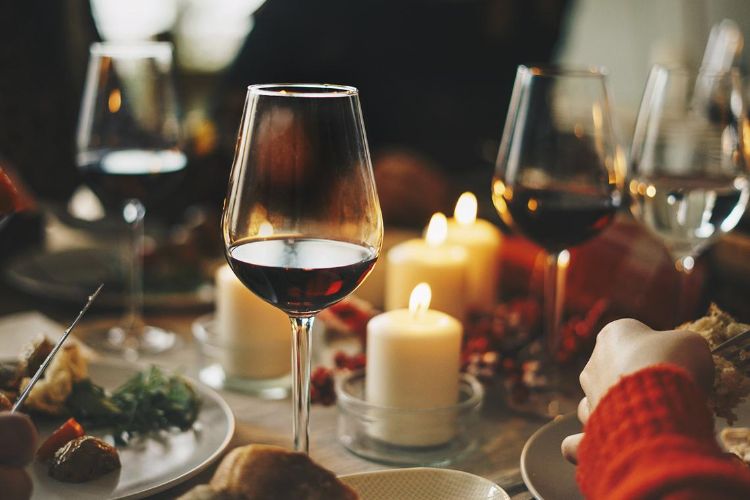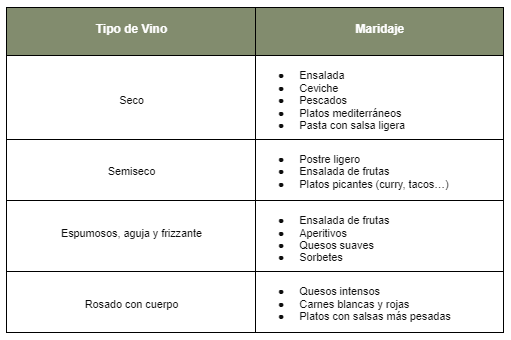
11 Dic Maridaje
Elegir el vino adecuado para acompañar las comidas navideñas es un punto clave para triunfar estas fiestas. Muchas veces asociamos el precio del vino a su calidad, pero esta correlación no siempre es tan clara.
Para elegir bien el vino es importante tener en cuenta nuestros gustos y el tipo de comida que queramos acompañar, es decir, el maridaje.
A continuación, desde Cuina Canela Fina te explicamos algunos trucos para mejorar tus maridajes y crear experiencias gastronómicas especiales:
¿Qué es el maridaje y cómo puede mejorar una comida?
El maridaje es el proceso de combinar alimentos y bebida, vino en este caso, con la finalidad de potenciar las características positivas de ambos productos. Hay dos tipos principales de maridaje:
- Por afinidad. En este tipo de maridaje se alinean aspectos como el sabor, el aroma y el color, tanto de la bebida como de la comida. La clave está en identificar sabores y sensaciones similares y proporcionarles un nexo de unión. Un ejemplo sería, un plato cocinado con romero y un vino con notas a romero.
- Por contraste. Se busca encontrar el equilibrio entre la bebida y la comida, compensando los excesos y las carencias de ambos. Un ejemplo sería, queso azul y vino dulce.

¿Qué tipo de comida se puede maridar con los principales estilos de vino?
A continuación, os presentamos, a grandes rasgos, las características principales de cada tipo de vino y algunas posibilidades de maridaje.

El vino tinto suele presentar diferentes tonalidades de rojo o incluso púrpura. El color puede variar según la variedad de uva utilizada, el proceso de vinificación y la edad del vino. Tiene un amplio espectro de aromas: fruta fresca, flores, hierbas, madera, entre otros. La acidez es un componente clave en el vino tinto, ya que le aporta frescura y/o equilibrio.
Podría decirse que existen cuatro categorías principales de vino tinto en nuestro país, teniendo en cuenta el tiempo de guarda y envejecimiento. La clasificación sería: Vino Joven (3-6 meses), Crianza (6-24 meses), Reserva (3 años) y Gran Reserva (5 años). Aun así, depende de la región de origen de la uva.
El vino rosado es un tipo de vino que se obtiene a partir de uvas negra. Su tono rosado va a depender de cuánto tiempo ha estado macerando, es decir cuánto tiempo han estado en contacto las uvas y las pieles antes de la fermentación para conseguir el color, aromas, etc. Suelen estar algunas horas macerando.
Existen una gran variedad de tipos de vino rosado, según las uvas que se hayan elegido o del proceso que se haya llevado a cabo para su elaboración.
Estos vinos tienen un sabor suave y ligero, con aromas afrutados y florales, por ese motivo, se considera un vino versátil. Sin embargo, a continuación, algunas pautas generales para maridar un vino rosado.


El Vino Blanco se elabora con uvas blancas o con tintas que se prensan sin la piel. A diferencia del vino tinto, el blanco se fermenta sin los hollejos, por eso carece de color. Además, es un vino más ligero.
Estos vinos también pueden ser clasificados según su elaboración y envejecimiento (joven, fermentado en barrica y crianza). Aun así, la clasificación principal de estos vinos se realiza según el nivel de dulce presente en el vino, el cual encajara mejor con un tipo de platos u otros.
El vino blanco combina a la perfección con las carnes blancas o estofados, pescados, quesos, olivas o fruta. También es tu aliado perfecto para los entrantes o aperitivos e, incluso, para tus postres.
¿Cuáles son los principales maridajes para las comidas navideñas?
Aperitivos navideños:
Muchos de los menús navideños comienzan con unos entrantes ligeros para ir abriendo el apetito, como ensaladas o canapés. La mejor opción sería acompañarlos con un vino blanco. Si los entrantes incluyen embutidos o quesos, sería mejor combinarlo con un vino tinto con cuerpo. Dependiendo de la intensidad de los embutidos, hay que tener en cuenta la clasificación aportada anteriormente; cuanta más intensidad en los sabores, será necesario un vino con más envejecimiento.
Primeros platos:
En estas fechas navideñas, algunos de los platos más típicos son los caldos y las sopas. Si la elaboración de estos es con carne y/o verduras, la mejor combinación será acompañarlos con un vino tinto joven. Pero si el primer plato incluye cremas suaves o canelones con bechamel, la mejor elección será un vino blanco fresco.
Pescado y marisco:
El mejor aliado para el marisco y el pescado casi siempre es el vino blanco.
Aun así, si vais a servir marisco con sabores intensos, como bogavante o gambas rojas, podría ser interesante maridarlo con un vino tinto crianza. Y en cuanto al pescado, si es un pescado con un sabor fuerte y característico, como el salmón o el atún, se podrían acompañar también con un vino tinto joven o un crianza.



Platos con carne
Tradicionalmente, los platos con carne se han acompañado siempre de vinos tintos. Aun así, hace falta identificar de qué tipo de carne se trata para encontrar su mejor maridaje y qué vino encaja según el envejecimiento.
Si las carnes son de ave, normalmente se combinan con vinos tintos suaves o incluso podría usarse un vino blanco. Si las carnes son de caza menor o carne de cerdo, tenderemos a acompañarlas con un vino tinto crianza. Por último, si es una receta con carne roja o carne de caza mayor, el vino que más potenciará su sabor será un vino tinto reserva o gran reserva.
Postres
Los postres son la oportunidad ideal para sorprender, por lo que resulta de vital importancia tener en cuenta el grado de dulzor del vino y el tipo de postre. Como truco, te recomendamos que cuanto más oscuro sea el color del postre, más oscuro debería ser el vino. Por ejemplo, postres de vainilla con vino blanco o postres con chocolate con vino tinto. También podría ser una buena opción utilizar algún vino dulce.


En resumen, para Cuina Canela Fina el conocimiento del maridaje en referencia a las comidas de navidad es esencial para la creación de una comida inolvidable estas fiestas. El maridaje de un menú navideño es solo un ejemplo de cómo podemos potenciar las características positivas de cada alimento o plato que se sirva o se cocine. Conocer los vinos y sus posibles maridajes siempre crea una experiencia gastronómica más completa.


Sorry, the comment form is closed at this time.